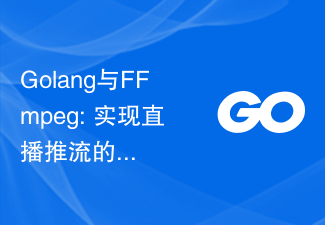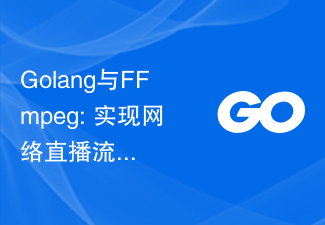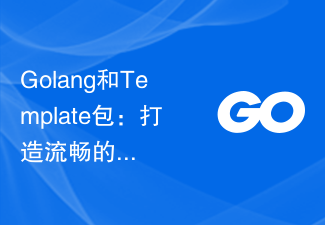 Backend Development
Backend Development Golang
Golang An in-depth analysis of Golang's commonly used standard libraries: helping you get twice the result with half the effort in programming!
An in-depth analysis of Golang's commonly used standard libraries: helping you get twice the result with half the effort in programming!
Full analysis of Golang’s commonly used standard libraries: Helping you program easily!
Introduction:
Golang is a concise and efficient programming language. Its standard library integrates rich functions to help developers easily complete various tasks. This article will introduce Golang's commonly used standard libraries one by one to help readers better understand and apply these libraries and improve development efficiency.
1. fmt library
fmt is a commonly used formatted input and output library in Golang, which can easily format, output and read data. Using the fmt library, you can output data to a terminal or file in a specified format, or you can read data from a terminal or file and format it. The fmt library also provides functions such as formatting strings and reading strings, which is very practical.
2. os library
The os library is a library used to operate operating system functions in Golang. It provides a series of functions for file operations, environment variable acquisition, process control and other functions. Developers can use the os library to create, open, read, write and other operations on files, and can also obtain information such as environment variables and command line parameters of the operating system.
3. Net library
The net library is a commonly used network programming library in Golang. It provides a series of functions and interfaces for network communication. Through the net library, developers can easily perform network programming on TCP, UDP, HTTP and other protocols. The net library also provides socket programming-related interfaces, allowing developers to use underlying network sockets for network communication operations.
4. http library
The http library is a library used to write HTTP servers and clients in Golang. It provides a series of functions and interfaces for processing HTTP requests and responses. Through the http library, developers can easily build HTTP servers and send HTTP requests. The http library also provides functions such as cookies, sessions, uploading and downloading files, etc., which is very practical.
5. json library
The json library is a library used to process JSON data in Golang. It provides a series of functions and interfaces for encoding and decoding JSON data. Developers can use the json library to convert Golang data structures into JSON strings, and can decode JSON strings into Golang data structures. The json library also provides some advanced features, such as custom encoding rules, processing non-standard JSON formats, etc.
6. Time library
The time library is a library used to process time and date in Golang. It provides a series of functions and interfaces for time and date operations. Through the time library, developers can obtain the current system time, perform time formatting, time addition and subtraction, and other operations. The time library also provides some advanced functions, such as timers, time zone processing, etc.
7. strconv library
The strconv library is a library in Golang for converting between basic data types and strings. It provides a series of functions for conversion between different types. Through the strconv library, developers can easily convert strings to basic types such as integers and floating point numbers, and also convert basic types to strings. The strconv library also provides some advanced functions, such as parsing strings with hexadecimal, formatted output, etc.
8. io library
The io library is a library used for input and output operations in Golang. It provides a series of interfaces and functions for file and stream operations. Developers can use the io library to read and write files, as well as read and write streams. The io library also provides some advanced functions, such as buffered reading, copying files, etc.
9. sync library
The sync library is a library for synchronization operations in Golang. It provides a series of functions and interfaces for concurrency and multi-thread control. Through the sync library, developers can use mutex locks, read-write locks, etc. to control concurrent access to shared resources, and can also use condition variables, wait groups, etc. for thread synchronization. The use of the sync library can help developers write concurrency-safe programs.
10. flag library
The flag library is a library used to parse command line parameters in Golang. It provides a series of functions and interfaces for defining and parsing command line parameters. Through the flag library, developers can easily define the names, default values, types, etc. of command line parameters, and can parse command line parameters and obtain their values. The flag library also provides some advanced functions, such as the definition and parsing of subcommands.
Conclusion:
This article introduces the commonly used standard libraries in Golang, including fmt, os, net, http, json, time, strconv, io, sync, flag and other libraries. These libraries provide rich functionality to help developers accomplish various tasks easily. Being familiar with and mastering the use of these libraries is very helpful for improving development efficiency and writing high-quality programs. I hope readers can better master the use of the Golang standard library through the introduction and practice of this article. come on!
The above is the detailed content of An in-depth analysis of Golang's commonly used standard libraries: helping you get twice the result with half the effort in programming!. For more information, please follow other related articles on the PHP Chinese website!
 Golang性能测试的方法与工具Aug 10, 2023 am 09:24 AM
Golang性能测试的方法与工具Aug 10, 2023 am 09:24 AMGolang性能测试的方法与工具引言:在软件开发中,性能测试是一个重要的环节。通过性能测试,开发人员可以验证程序的性能并找出潜在的性能瓶颈。Golang作为一门高性能的编程语言,也提供了一些方法与工具来帮助开发人员进行性能测试。本文将介绍Golang中几种常用的性能测试方法与工具,并附带代码示例。一、基准测试Golang提供了内置的基准测试框架,可以方便地进
 Golang与FFmpeg: 实现直播推流的技术实现Sep 27, 2023 pm 12:28 PM
Golang与FFmpeg: 实现直播推流的技术实现Sep 27, 2023 pm 12:28 PMGolang与FFmpeg:实现直播推流的技术实现,需要具体代码示例引言:近年来,直播技术的快速发展与普及,使得直播成为了一种越来越受欢迎的传媒方式。而其中,实时推流技术是实现直播的关键。本文将介绍如何利用编程语言Golang和多媒体处理工具FFmpeg实现直播推流的技术实现,并提供一些相关的代码示例。一、Golang与FFmpeg技术简介1.1
 Golang与FFmpeg: 如何实现音频解码与编码Sep 27, 2023 am 10:49 AM
Golang与FFmpeg: 如何实现音频解码与编码Sep 27, 2023 am 10:49 AMGolang与FFmpeg:如何实现音频解码与编码,需要具体代码示例导语:随着多媒体技术的不断发展,音频处理已经成为很多应用程序中必不可少的一部分。本文将介绍如何使用Golang和FFmpeg库来实现音频解码与编码的功能,并提供具体的代码示例。一、什么是FFmpeg?FFmpeg是一款功能强大的开源多媒体处理工具,可以实现音频和视频的解码、编码、转换、流媒
 Golang图像处理:学习如何实现图片的高斯模糊效果Aug 17, 2023 pm 12:06 PM
Golang图像处理:学习如何实现图片的高斯模糊效果Aug 17, 2023 pm 12:06 PMGolang图像处理:学习如何实现图片的高斯模糊效果引言:图像处理在计算机视觉领域中起着重要的作用。在图像处理中,高斯模糊是一种常用的技术,用于对图像进行模糊处理,以减少图像中的噪点和细节。在本文中,我们将学习如何使用Golang实现图片的高斯模糊效果,并附上代码示例。环境准备:首先,确保已经正确安装了Golang开发环境。通过在终端或命令提示符中
 C/C++中的优先队列介绍Sep 13, 2023 pm 05:21 PM
C/C++中的优先队列介绍Sep 13, 2023 pm 05:21 PM优先级队列是一种队列,其中根据分配给它们的优先级插入或删除元素,其中优先级是范围在0-10之间的整数值,其中0表示具有最高优先级的元素,10表示具有最高优先级的元素优先级最低的元素。实现优先级队列遵循两条规则:具有最高优先级的数据或元素将在具有最低优先级的数据或元素之前执行。如果两个元素具有相同的优先级,则它们将按照它们添加到列表中的顺序执行。有多种可用的数据结构可用于实现优先级队列如堆栈、队列和链表。在本文中,我们将解释队列数据结构。有两种方法可以用来实现优先级队列,例如-在单个数组中维护多个
 Golang与FFmpeg: 实现网络直播流媒体的推送技术Sep 29, 2023 pm 02:22 PM
Golang与FFmpeg: 实现网络直播流媒体的推送技术Sep 29, 2023 pm 02:22 PMGolang与FFmpeg:实现网络直播流媒体的推送技术,需要具体代码示例摘要:随着网络直播的流行,越来越多的开发者开始关注如何实现流媒体的推送技术。本文将介绍如何使用Golang与FFmpeg结合,来实现网络直播流媒体的推送。通过具体的代码示例,将引导读者一步一步地了解如何搭建基于Golang和FFmpeg的推送系统。一、Golang语言介绍Golang
 如何使用Golang对图片进行渐进式加载和压缩处理Aug 18, 2023 pm 12:46 PM
如何使用Golang对图片进行渐进式加载和压缩处理Aug 18, 2023 pm 12:46 PM如何使用Golang对图片进行渐进式加载和压缩处理一、引言现如今,互联网上图片的使用已经变得异常普遍。然而,大图加载慢、无法渐进式显示的问题也频繁出现,影响了用户的体验。本文将介绍如何使用Golang对图片进行渐进式加载和压缩处理,提高用户的加载速度和体验。二、渐进式加载所谓渐进式加载,就是在图片还未完全加载完成之前,可以渐进式地显示出其质量提高的小部分。在
 Golang和Template包:打造流畅的网页体验Jul 17, 2023 am 10:57 AM
Golang和Template包:打造流畅的网页体验Jul 17, 2023 am 10:57 AMGolang和Template包:打造流畅的网页体验在当今互联网时代,网页的用户体验对于网站的成功至关重要。随着网页技术的不断发展和创新,开发人员需要选用高效、简洁的工具来构建流畅的用户界面。在Golang开发领域,Template包是一款强大的工具,有助于开发人员实现快速、可维护的网页模板。Template包是Golang标准库中自带的模板引擎,它提供了一


Hot AI Tools

Undresser.AI Undress
AI-powered app for creating realistic nude photos

AI Clothes Remover
Online AI tool for removing clothes from photos.

Undress AI Tool
Undress images for free

Clothoff.io
AI clothes remover

AI Hentai Generator
Generate AI Hentai for free.

Hot Article

Hot Tools

DVWA
Damn Vulnerable Web App (DVWA) is a PHP/MySQL web application that is very vulnerable. Its main goals are to be an aid for security professionals to test their skills and tools in a legal environment, to help web developers better understand the process of securing web applications, and to help teachers/students teach/learn in a classroom environment Web application security. The goal of DVWA is to practice some of the most common web vulnerabilities through a simple and straightforward interface, with varying degrees of difficulty. Please note that this software

SublimeText3 Mac version
God-level code editing software (SublimeText3)

PhpStorm Mac version
The latest (2018.2.1) professional PHP integrated development tool

Safe Exam Browser
Safe Exam Browser is a secure browser environment for taking online exams securely. This software turns any computer into a secure workstation. It controls access to any utility and prevents students from using unauthorized resources.

Zend Studio 13.0.1
Powerful PHP integrated development environment





